| LESSER KNOWN PLAYWRIGHTS |
| Latest update: 2025-11-30 | |
| Arashi Sangy˘ Arashi Sangy˘ |
|
|
Dates of birth and death unknown. He was recorded for the first time in the 11th lunar month of 1796, when he worked for a common kaomise program for the Kitagawa no Shibai (Ky˘to) and the Kado no Shibai (ďsaka); he worked, along with Chikamatsu Tokuz˘, Nagawa Tokusuke I, Nagawa Kunisuke and Chikamatsu Monky˘, on the kaomise drama "Yama Katsura Asahi no Menbako", which was staged in Ky˘to from the 5th day and in ďsaka from the 18th day and celebrated the shűmei of Onoe Koisabur˘ I. He worked in the 11th lunar month of 1798 in Ky˘to at the Minamigawa no Shibai, along with Namiki Jűsuke II and Namiki Miyosuke, on the kaomise drama "Nanboku Yuki no Miyako", which celebrated the shűmei of Arashi Raishi I and Arashi Sangor˘ III. He was recorded for the last time in the 8th lunar month of 1807, in ďsaka at the Naka no Shibai, where he worked on Iso Isosuke's drama "Yamato Kotoba Suikoden". No record afterwards. |
|
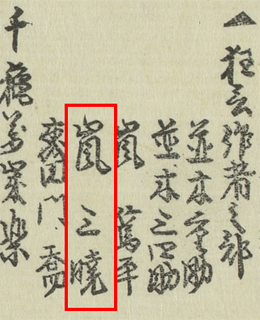 |
|
|
The name of Arashi Sangy˘ in a 1798 ďsaka hy˘banki (the name within the red box) |
|
| Chikamachi Jisuke Chikamachi Jisuke |
|
|
Dates of birth and death unknown. Related to the Chikamatsu clan. He was recorded for the first time in the 11th lunar month of 1822, in ďsaka at the Naka no Shibai, where he worked on the drama "Sugawara Denju Tenarai Kagami". He took the name of Chikamachi Jisuke in the 11th lunar month of 1825 and he worked at the Kado no Shibai on the kaomise drama "Ume no Naniwa Hayazaki Genji", which celebrated the shűmei of Nakayama Bungor˘ II. He was recorded for the last time in the 1826 Kamigata hy˘banki. No record afterwards. |
|
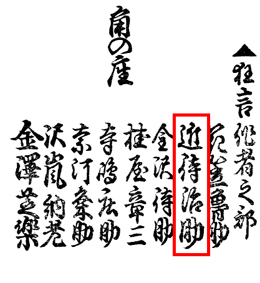 |
|
|
The name of Chikamachi Jisuke in a 1826 Kamigata hy˘banki (the name within the red box) |
|
| Chikamatsu Tokubei Chikamatsu Tokubei |
|
|
Dates of birth and death unknown. Disciple of Chikamatsu Tokuz˘, his pen name was Chikamatsu Tokubei. He was recorded for the first time in the 3rd lunar month of 1799, in ďsaka at the Kado no Shibai, where he worked on the drama "Ishi Tatami Futaba no Jinmaku". He was recorded for the last time in the 3rd lunar month of 1806, in ďsaka at the Kado no Shibai, where he worked on the drama "Kokusen'ya Gassen". No record afterwards. |
|
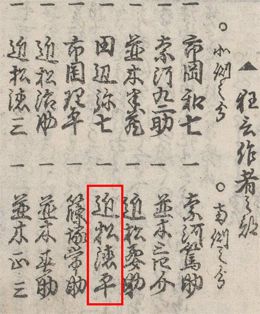 |
|
|
The name of Chikamatsu Tokubei in a 1806 Ky˘to hy˘banki (the name within the red box) |
|
| Chikamatsu Tokuji Chikamatsu Tokuji [38] |
|
|
Dates of birth and death unknown. Disciple of Chikamatsu Tokuz˘, his pen name was Chikamatsu Tokuji. He was recorded for the first time in the 11th lunar month of 1804, in Ky˘to at the Kitagawa no Shibai, where he worked, along with his master Chikamatsu Tokuz˘, Namiki Miyosuke and Nagawa Kunisuke [39], on the kaomise drama "Ichiy˘ ďgi no Kachidoki". He was recorded for the last time in the 1st lunar month of 1805, in the same theater, where he worked on the new year ni-no-kawari drama "Keisei Miyako Yoshino" and the dance-drama "Matsu no Suma-goto". No record afterwards. |
|
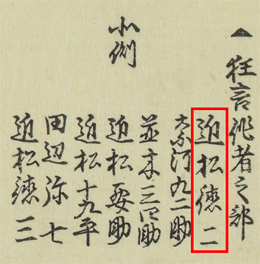 |
|
|
The name of Chikamatsu Tokuji in a 1805 Ky˘to hy˘banki (the name within the red box) |
|
| Hirata Bunji Hirata Bunji |
|
|
Dates of birth and death unknown. He was recorded for the first time in the 1st lunar month of 1765, when he worked at the Ichimuraza on the new year sogamono drama "Iro J˘go Mikumi Soga". He was recorded for the last time a few years later, when he worked in the 11th lunar month of 1768 at the Nakamuraza on the kaomise drama "Ima o Sakari Suehiro Genji" [3], which celebrated the arrival in Edo of the Kamigata star Nakamura Utaemon I and the shűmei of Osagawa Tsuneyo II. No record afterwards. |
|
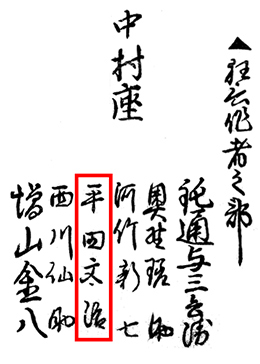 |
|
|
The name of Hirata Bunji in a 1769 Edo hy˘banki (the name within the red box) |
|
| Ich˘ Reisuke Ich˘ Reisuke |
|
|
Dates of birth and death unknown. He was recorded for the first time in the 11th lunar month 1852 in Ky˘to at the Minamigawa no Shibai, where he worked with Shimizu Sh˘shichi II and Namiki Ukitsu on the drama "Tsugiawase Koshiji no Meiboku". He went to Edo and worked with Sakurada Jisuke III and Fukumori Kyűsuke III in the 3rd lunar month of 1855 at the Nakamuraza on the new year sogamono drama "Hanabutai Banjaku Soga". He was recorded for the last time in the 1st lunar month of 1857 in Edo at the Ichimuraza, where he worked with Sakurada Jisuke III and Nakamura Shichir˘zaemon on the new year sogamono drama "Toshitoku Matsu no Shimadai". No record afterwards. |
|
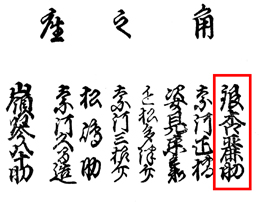 |
|
|
The name of Ich˘ Reisuke in a 1854 Kamigata hy˘banki (the name within the red box) |
|
| Ichioka Rihei Ichioka Rihei |
|
|
Dates of birth and death unknown. Disciple of Ichioka Washichi I, he was recorded for the first time in the 1sth lunar month of 1805, in ďsaka at the Kado no Shibai, where he worked, along with Chikamatsu Tokuz˘, his master Ichioka Washichi I, Namiki Harusuke and Egawa Sadashichi, on the new year ni-no-kawari drama "Koi M˘de Kiyomizu Zakura", which was produced by Arashi Torasabur˘. He was recorded for the last time in the 1807 ďsaka hy˘banki, which was published in the 1st lunar month of 1807. No record afterwards. |
|
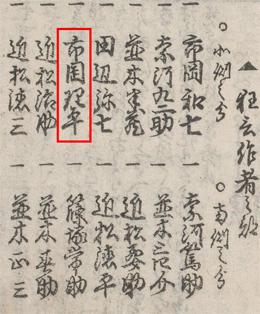 |
|
|
The name of Ichioka Rihei in a 1806 ďsaka hy˘banki (the name within the red box) |
|
| Ichiyama Bokuhei Ichiyama Bokuhei |
|
|
Dates of birth and death unknown. He was a Kabuki actor belonging to the Ichiyama clan at the beginning of his career. He was most likely a disciple of the actor Ichiyama Sukegor˘ I [37] and performed as a katakiyaku. He switched to sakusha and was recorded for the first time in the 9th lunar month of 1751, when he worked in ďsaka at the Kado no Shibai on the drama "Oda Gunki Momiji no Kinugasa" which was the onagori ky˘gen for the actor Fujikawa Heikur˘ about to go to Edo. He settled in Ky˘to in Fall 1755 and worked in the 11th lunar month of 1755 at the Kitagawa no Shibai on the kaomise drama "Onna Monji Heike Monogatari". He went back to ďsaka in Fall 1757 and worked in the 11th lunar month of 1757 at the ďnishi no Shibai on the kaomise drama "Shiki Sanban Okina Kagami". He was recorded for the last time in 1764, in ďsaka at the Kado no Shibai, where he worked in the 11th lunar month of 1764 on the kaomise drama "Momotar˘ Obako Banashi", which celebrated the shűmei of Yoshizawa Ayame III. No record afterwards. |
|
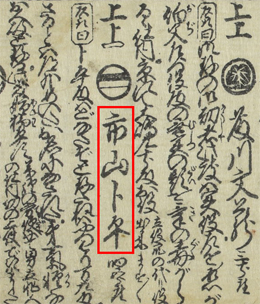 |
|
|
The name of Ichiyama Bokuhei in a 1746 ďsaka hy˘banki (the name within the red box) |
|
| Iozaki Kyűsuke Iozaki Kyűsuke |
|
|
Dates of birth and death unknown. He was recorded for the first time in the 11th lunar month of 1818, when he worked at the Tamagawaza on the kaomise drama "Shitenn˘ Ubuyu no Tamagawa". He was recorded for the last time the following year, when he worked in the 7th lunar month of 1818 in the same theater on the natsu ky˘gen "Ch˘-mo Hiyoku Yamazaki Odori". No record afterwards. |
|
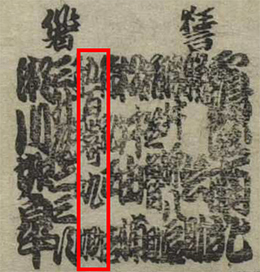 |
|
|
The name of Iozaki Kyűsuke in a 1819 Tamagawaza ehon banzuke (the name within the red box) |
|
| Kadota Ky˘suke Kadota Ky˘suke |
|
|
Dates of birth and death unknown. He was recorded for the first time in the 11th lunar month of 1810, when he worked at the Ichimuraza on the kaomise drama "Shitenn˘ Yagura no Ishizue" [2]. He was recorded for the last time the following year, when he worked in the 3rd lunar month of 1811 in the same theater on the yayoi ky˘gen "Jidai Sewa Suikoden". No record afterwards. |
|
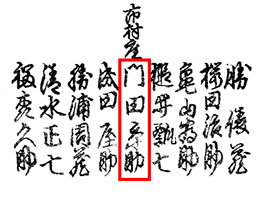 |
|
|
The name of Kadota Ky˘suke in a 1819 Edo hy˘banki (the name within the red box) |
|
| Kanazawa Ginsuke Kanazawa Ginsuke |
|
|
Dates of birth and death unknown. Disciple of Kanazawa Ryűgoku I, he received the name of Kanazawa Ginsuke He was active in Kamigata from the second half of the 1820s to the second half of the 1830s. No record afterwards. |
|
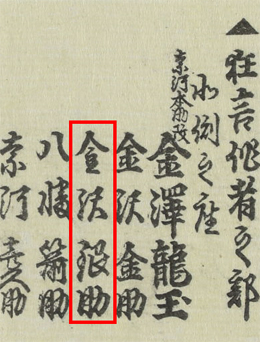 |
|
|
The name of Kanazawa Ginsuke in a 1834 Ky˘to hy˘banki (the name within the red box) |
|
| Kanazawa Kinsuke Kanazawa Kinsuke |
|
|
Dates of birth and death unknown. Disciple of Kanazawa Ryűgoku I, he received the name of Kanazawa Kinsuke He was active in Kamigata from the beginning of the 1820s to the second half of the 1830s. No record afterwards. |
|
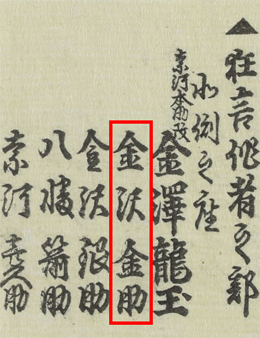 |
|
|
The name of Kanazawa Kinsuke in a 1834 Ky˘to hy˘banki (the name within the red box) |
|
| Matsui Seiz˘ Matsui Seiz˘ |
|
|
Dates of birth and death unknown. He was recorded for the first time in 1760, when he worked at the Nakamuraza. He worked for the tatesakusha Horikoshi Nis˘ji I [28] in the 11th lunar month of 1761 at the Ichimuraza on the kaomise drama "Wakamusha Koky˘ no Nishiki". He also worked in the same theater in the 1st lunar month of 1762 on the new year sogamono drama "Nokon no Yuki Katsuiro Soga" [29]. No record afterwards. |
|
| Matsukawa Sada Matsukawa Sada |
|
|
Dates of birth and death unknown. He was recorded for the first time in 1782 in Kamigata. He was recorded for the last time when he worked in the 7th lunar month of 1790 in Ky˘to on the drama "Oriawase Muromachi Nishiki". No record afterwards. |
|
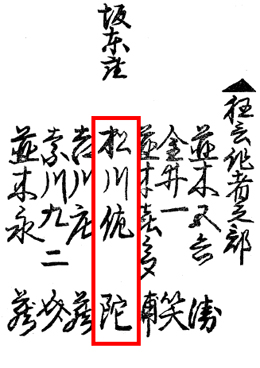 |
|
|
The name of Matsukawa Sada in a 1786 ďsaka hy˘banki (the name within the red box) |
|
| Matsushima Kumesuke Matsushima Kumesuke |
|
|
Dates of birth and death unknown. He was recorded for the first time in the 4th lunar month of 1856, when he worked at the Nakamuraza on the drama "Hitokana-de Kodakara Soga" which celebrated the shűmei of Kataoka Gat˘ II. He was recorded for the last time when he worked in the 2nd lunar month of 1864 at the Moritaza on the drama "Kinoene Soga Daikoku Bashira". No record afterwards. |
|
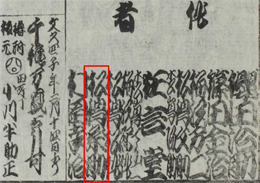 |
|
|
The name of Matsushima Kumesuke in a 1864 Moritaza ehon banzuke (the name within the red box) |
|
| Matsuzawa Bunroku Matsuzawa Bunroku |
|
|
Dates of birth and death unknown. He was recorded for the first time in the 11th lunar month of 1750, when he worked at the Ichimuraza for the tatesakusha Fujimoto Tobun [30] on the kaomise drama "Gaijin Taiheiki", which celebrated the shűmei of Band˘ Sanpachi I. Bunroku worked in the 2nd lunar month of 1752 at the Ichimuraza on the new year drama "Hatsuhana Sumidagawa", which included a "Uir˘ Uri" scene. He was recorded for the last time when he worked [31] in the 11th lunar month of 1757 at the Nakamuraza on the kaomise drama "Onna Musha Kaijin Yashima". No record afterwards. |
|
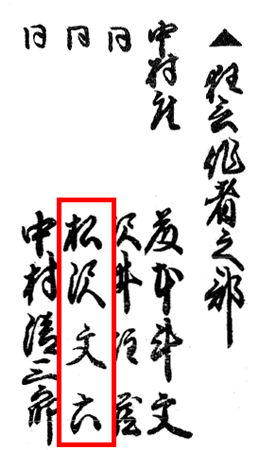 |
|
|
The name of Matsuzawa Bunroku in a 1754 Edo hy˘banki (the name within the red box) |
|
| Meita Bunz˘ Meita Bunz˘ |
|
|
Dates of birth and death unknown. He was recorded for the first time in the 11th lunar month of 1827, in Edo at the Kawarasakiza, where he worked on Tsuruya Nanboku IV's kaomise drama "Muro no Ume H˘gan Biiki" [40]. He also worked in the 1st lunar month of 1828 in the same theater on the new year sogamono drama "Iriyamagata Soga no Saiken". He was recorded for the last time in the 2nd lunar month of 1828, in Edo at the Kawarasakiza, where he worked on the drama "Toki no Hana Date no Sakigaki", which was based on the sekai of "Meiboku Sendai Hagi". No record afterwards. |
|
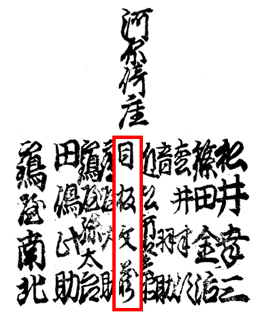 |
|
|
The name of Meita Bunz˘ in a 1828 Edo hy˘banki (the name within the red box) |
|
| Nagawa J˘suke Nagawa J˘suke |
|
|
Dates of birth and death unknown. Unknown master. He was recorded for the first time in the 4th lunar month of 1775, in ďsaka at the Naka no Shibai, where he worked for Nagawa Kamesuke I on the drama "Hade Kurabe Ise Monogatari". He was recorded for the last time in the 11th lunar month of 1778, in ďsaka at the Naka no Shibai, where he worked on the kaomise drama "Toki-ni T˘dai Sennin Kagami". No record afterwards. |
|
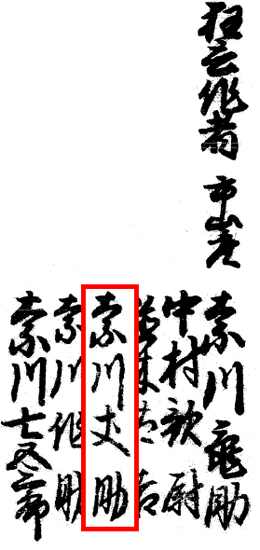 |
|
|
The name of Nagawa J˘suke in a 1778 ďsaka hy˘banki (the name within the red box) |
|
| Naka Kiichi Naka Kiichi I |
|
|
Dates of birth and death unknown. He was recorded for the first time in the 11th lunar month of 1769, when he worked at the Ichimuraza on the kaomise drama "Mutsu no Hana Ume no Kaomise" [9], which welcomed in Edo the actors Onoe Kikugor˘ I, ďtani Tomoemon I, Nakamura Kiyosabur˘ I and Onoe Tamiz˘ I. He took the name of Naka Kiichi the folliowing year and worked in the same theater on the new year sogamono drama "Fuji no Yuki Kaikei Soga" [10]. He worked on Sakurada Jisuke I's lavish kaomise drama "Gohiiki Kanjinch˘" [11], which was premiered in the 11th lunar month of 1773 in Edo at the Nakamuraza [casting]. This kaomise program celebrated the shűmei of Nakamura Rik˘ I. He worked in the same theater in the 7th lunar month of 1775 on the drama "Kanadehon Chűshingura". No record afterwards. |
|
| Nakagawa Sh˘emon Nakagawa Sh˘emon |
|
|
Dates of birth and death unknown. He was recorded for the first time in ďsaka in 1783. He worked in the 8th lunar month of 1784 in ďsaka at the Naka no Shibai on the drama "Inabikari Tagoto no Tsuki" [12]. He worked in the 8th lunar month of 1786 in ďsaka at the Nishi no Shibai on the drama "ďgamiuchi Koi no Migawari" [13]. He was active in Kamigata up to 1787. No record afterwards. |
|
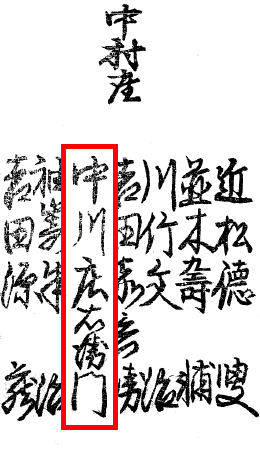 |
|
|
The name of Nakagawa Sh˘emon in a 1786 ďsaka hy˘banki (the name within the red box) |
|
| Nakamatsu Bunz˘ Nakamatsu Bunz˘ |
|
|
Dates of birth and death unknown. He was recorded for the first time in the 11th lunar month of 1752, when he worked at the Minamigawa no Shibai on the kaomise drama "Hatsubaika Asahi no Minato" [14]. He most likely worked the following year in the same theater in the 1st lunar month of 1753 on the ni-no-kawari drama "Keisei Naruo no Umi". No record afterwards. |
|
| Nakamura Kawashichi Nakamura Kawashichi |
|
|
Dates of birth and death unknown. He was recorded for the first time in 1777. He worked for the tatesakusha Okuno Sasuke in the 11th lunar month of 1778 at the Moritaza on the kaomise drama "Date Nishiki Tsui no Yumitori". He was recorded for the last time in the 3rd lunar month of 1786, in ďsaka at the ďnishi no Shibai, where he worked, along with Namiki Gohŕ, Chikamatsu Tokus˘ and Tamekawa S˘suke, on the drama "ďminato Koi no Yarikuri". No record afterwards. |
|
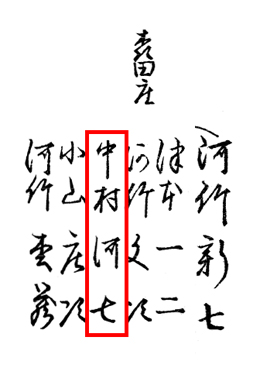 |
|
|
The name of Nakamura Kawashichi in a 1780 Edo hy˘banki (the name within the red box) |
|
| Nakamura Raisuke Nakamura Raisuke |
|
|
Dates of birth and death unknown. He was recorded for the first time in the 11th lunar month of 1778, in Edo at the Ichimuraza, where he worked, along with Masuyama Kinpachi I, Nakamura Seikur˘ II, Ichizuka Taiji and Tsutsui Hanji, on the kaomise drama "Sakimasuya Ume no Kachidoki", which welcomed in Edo the actors Onoe Kikugor˘ I and Otowa Jir˘za II and celebrated the shűmei of Ikushima Daikichi IV. In the 8th lunar month of 1799, he worked in the same theater on the drama "Shin Usuyuki Monogatari", which starred Onoe Kikugor˘ I, Sawamura S˘jűr˘ III, Segawa Kikunoj˘ III, Yamashita Kinsaku II, Ichimura Uzaemon IX, Band˘ Hikosabur˘ III, ďtani Hiroji III, Sakata Hangor˘ II, Nakamura Sukegor˘ II and Sawamura Shirogor˘ I. He was recorded for the last time in the 11th lunar month of 1784, in Edo at the Nakamuraza, where he worked on the kaomise drama "ďakinai Hiru-ga-Kojima", along with Masuyama Kinpachi I and Sakurada Jisuke I, which celebrated the shűmei of Sanogawa Ichimatsu III, Sanj˘ Kantar˘ IV and Nakajima Mihoz˘ III and the return in Edo of ďtani Hiroemon III. No record afterwards. |
|
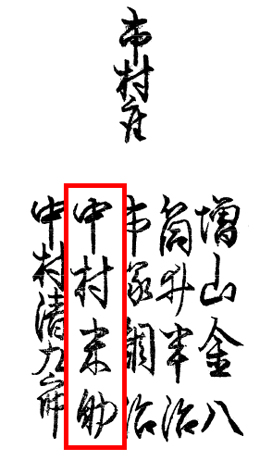 |
|
|
The name of Nakamura Raisuke in a 1779 Edo hy˘banki (the name within the red box) |
|
| Nakamura Seijűr˘ Nakamura Seijűr˘ |
|
|
Dates of birth and death unknown. He was recorded for the first time in the 11th lunar month of 1755, when he worked at the Moritaza on the kaomise drama "ďtomo no Kuronushi Sokutai Kagami" [15]. He was recorded for the last time in the 11th lunar month of 1764, when he worked at the Moritaza on the kaomise drama "Gyosei Kanatami no Megumi" [16]. No record afterwards. |
|
| Nakamura Shichir˘zaemon Nakamura Shichir˘zaemon |
|
|
Dates of birth and death unknown. He was recorded for the first time in the 3rd lunar month of 1855, in Edo at the Nakamuraza, where he worked on the new year sogamono drama "Hana Butai Banjaku Soga". He was recorded for the last time in the 1st lunar month of 1862, in Edo at the Nakamuraza, where he worked for the tatesakusha Ky˘gend˘ Sak˘ II on the new year sogamono drama "Sano Keizu Soga no Gosho-zome". This minor sakusha was active only at the Nakamuraza. No record afterwards. |
|
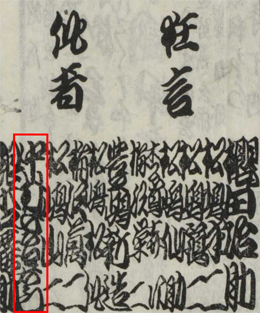 |
|
|
The name of Nakamura Shichir˘zaemon in a 1857 Nakamuraza yakuwari banzuke (the name within the red box) |
|
| Nakanogawa T˘shichi Nakanogawa T˘shichi |
|
|
Dates of birth and death unknown. He was recorded for the first time in the 11th lunar month of 1752, when he worked at the Minamigawa no Shibai on the kaomise drama "Hatsubaika Asahi no Minato" [17]. He most likely worked the following year in the same theater in the 1st lunar month of 1753 on the ni-no-kawari drama "Keisei Naruo no Umi". No record afterwards. |
|
| Nakata Mansuke Nakata Mansuke |
|
|
Dates of birth and death unknown. Disciple of Nakamura Kaemon, he was recorded for the first time in the 6th lunar month of 1721, when he worked in Ky˘to on the drama "Keisei Asahi no Taki" [19]. He settled in ďsaka in Fall 1738. He worked in the 11th lunar month of 1738 at the ďnishi no Shibai with the Edo sakusha Tsuuchi Jihŕ II [20] on the kaomise drama "Kusunoki Yakata Sennen Gitsune", which was produced in ďsaka by Yoshizawa Ayame II. He worked in the 11th lunar month of 1741 at the ďnishi no Shibai on the kaomise drama "Bankoku Taiheiki", which welcomed in ďsaka the Edo actors Ichikawa Ebiz˘ II and his adopted son Ichikawa Danjűr˘ III. The following year, he worked on the drama "Narukami Fud˘ Kitayama Zakura" [21], which was premiered in the 1st lunar month of 1742 at the ďnishi no Shibai [casting]. He was recorded for the last time when he worked in the 7th lunar month of 1742 in the same theater on the drama "Hoshiai Sakae Kagekiyo", which included a revised version of in the 1740 play "Nanatsu Men". No record afterwards. |
|
| Nakayama Otohachi Nakayama Otohachi |
|
|
Dates of birth and death unknown. He was recorded for the first time in the 11th lunar month of 1752, when he worked at the Minamigawa no Shibai on the kaomise drama "Hatsubaika Asahi no Minato" [18]. He most likely worked the following year in the same theater in the 1st lunar month of 1753 on the ni-no-kawari drama "Keisei Naruo no Umi". No record afterwards. |
|
| Namiki Iwaz˘ Namiki Iwaz˘ |
|
|
Dates of birth and death unknown. Disciple of Namiki Gohŕ, he was recorded for the first time in the 11th lunar month of 1781, in ďsaka at the Kado no Shibai, where he worked for his master [36] on the kaomise drama "Tensha Yorozu Yoshitsune Biiki", which was produced by Fujikawa Sango. He was active in ďsaka up to 1786. No record afterwards. |
|
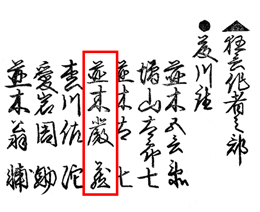 |
|
|
The name of Namiki Iwaz˘ in a 1783 ďsaka hy˘banki (the name within the red box) |
|
| Namiki Shinz˘ Namiki Shinz˘ |
|
|
Dates of birth and death unknown. Disciple of Namiki Gohŕ, he was recorded for the first time in the 11th lunar month of 1777, in ďsaka at the Kado no Shibai, where he worked for his master [35] on the kaomise drama "ďiri Kabuki no Tsuitachi", which was produced by Ogawa Kichitar˘ I and celebrated the shűmei of Shibazaki Rinzaemon II. He was recorded for the last time in the 11th lunar month of 1804 at the Naka no Shibai, where he worked for Nagawa Tokusuke I and Tatsuoka Mansaku on the kaomise "Minoriyoshi Kane no Naruki", which was produced by Yoshizawa Enjir˘ I. No record afterwards. |
|
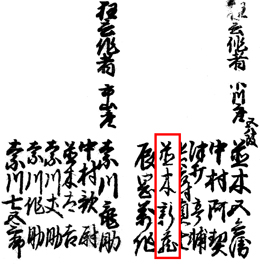 |
|
|
The name of Namiki Shinz˘ in a 1778 ďsaka hy˘banki (the name within the red box) |
|
| Nemoto Mosaku Nemoto Mosaku |
|
|
Dates of birth and death unknown. Unknown master. He was recorded for the first time in the 4th lunar month of 1766, in Ky˘to at the Kitagawa no Shibai, where he worked, along with Nakayama Gohachi, on the drama "Genji Gojűyoj˘ no Maki". He was recorded for the last time in the 11th lunar month of 1767, in Ky˘to, where he worked on the kaomise drama "Shinchoku Fukki no Kanatoko", which was produced by Ichiyama Sukegor˘ III and celebrated the shűmei of Sakakiyama Koshir˘ IV and Sakakiyama Shirotar˘ IV. No record afterwards. |
|
| Nishikawa Sensuke Nishikawa Sensuke |
|
|
Dates of birth and death unknown. Unknown master. He was recorded for the first time in the 11th lunar month of 1768, in Edo at the at the Nakamuraza, where he worked for Masuyama Kinpachi I [33] on the kaomise drama "Ima o Sakari Suehiro Genji", which celebrated the arrival in Edo of the Kamigata star Nakamura Utaemon I and the shűmei of Osagawa Tsuneyo II. He worked for Sakurada Jisuke I [32] in the 11th lunar month of 1769 at the at the Nakamuraza on the kaomise drama "Kawaranu Hanasakae Hachinoki". He was recorded for the last time in the 1st lunar month of 1770, in the same theater, where he worked on the new year sogamono drama "Kagamigaike Omokage Soga". No record afterwards. |
|
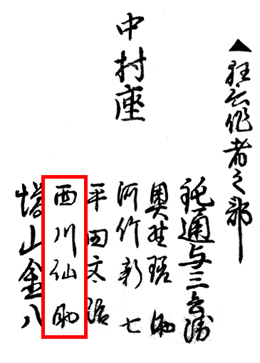 |
|
|
The name of Nishikawa Sensuke in a 1769 Edo hy˘banki (the name within the red box) |
|
| Nora Aisuke Nora Aisuke |
|
|
Dates of birth and death unknown. Unknown master. He was recorded for the first time in the 2nd lunar month of 1786, in Edo at the Moritaza, where he worked on the new year sogamono drama "Hana no Oedo Megumi Soga". He was recorded for the last time in the 8th lunar month of 1787, in Edo at the Nakamuraza, where he worked on the drama "Imagawa Honry˘ Mitsugi no Irifune". No record afterwards. |
|
| ďi Isabur˘ ďi Isabur˘ |
|
|
Dates of birth and death unknown. He was recorded for the first time in the 2nd lunar month of 1788, when he worked in ďsaka at the ďnishi no Shibai on Nagawa Shimesuke I's drama "Gishinden Yomikiri K˘shaku" [43]. He was recorded for the last time in the 5th lunar month of 1792, when he worked in ďsaka at the Kado no Shibai on the drama "Kaikei Fuji no Homare". No record afterwards. |
|
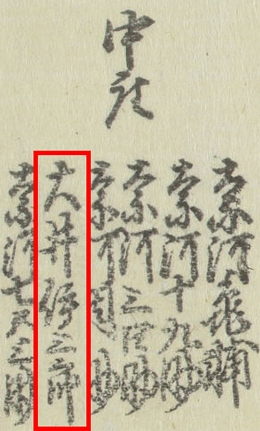 |
|
|
The name of ďi Isabur˘ in a 1790 ďsaka hy˘banki (the name within the red box) |
|
| ďkuma Shűz˘ ďkuma Shűz˘ |
|
|
Dates of birth and death unknown. He was recorded for the first time in the 11th lunar month of 1774, when he worked in Edo, along with Horikoshi Saiy˘ and Nakamura Jűsuke II [42], on the kaomise drama "Chigo Sakura Jűsangane", which celebrated the shűmei of Segawa Kikunoj˘ III. Then, he was recorded in the hy˘banki, which was published in the 1st lunar month of 1775. No record aftrwards. In Nojima Jusabur˘'s book "Kabuki Jinmei Jiten", he was recorded as ďkoshi Shűz˘, not ďkuma Shűz˘. |
|
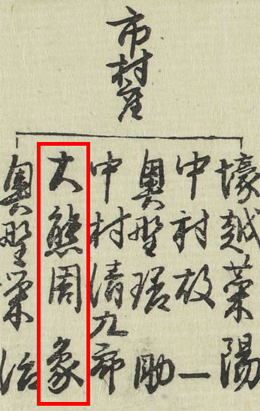 |
|
|
The name of ďkuma Shűz˘ in a 1775 Edo hy˘banki (the name within the red box) |
|
| Okuno Eiji Okuno Eiji |
|
|
Dates of birth and death unknown. Disciple of Okuno Sasuke, he was recorded for the first time in the 11th lunar month of 1773, when he worked at the Nakamuraza on the kaomise drama "Gohiiki Kanjinch˘" [4]. This 46-days long performance, which also celebrated the shűmei of Nakamura Rik˘ I, was a tremendous success. He was recorded for the last time when he worked in the 11th lunar month of 1778 at the Moritaza on the kaomise drama "Date Nishiki Tsui no Yumitori". No record afterwards. |
|
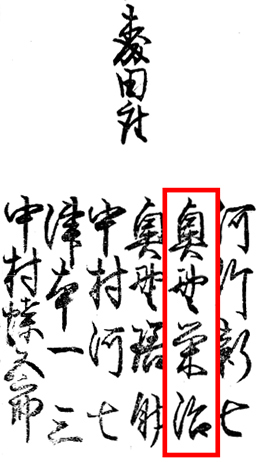 |
|
|
The name of Okuno Eiji in a 1779 Edo hy˘banki (the name within the red box) |
|
| ďya Jinkichi ďya Jinkichi |
|
|
Dates of birth and death unknown. He was recorded for the first time in the 4th lunar month of 1782, in ďsaka at the at the Kado no Shibai, where he worked for Namiki Gohei I and Nagawa Kamesuke I on the drama "Ni˘mon Hauta no Rakugaki", which was produced by Fujikawa Sango. In the 11th lunar month of 1782, he worked at the Naka no Shibai for Nagawa Shimesuke I on the kaomise drama "Zu ni Notta Bankoku Tokai", which celebrated the shűmei of Kagaya Kashichi I. He was recorded for the last time in the 1st lunar month of 1823, in the same theater, where he worked on the drama "Kanadehon Chűshingura". No record afterwards. |
|
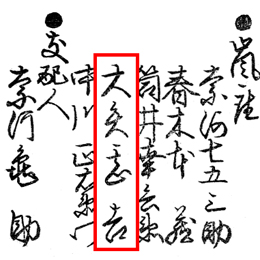 |
|
|
The name of ďya Jinkichi in a 1783 ďsaka hy˘banki (the name within the red box) |
|
| Oyomi Eisuke Oyomi Eisuke |
|
|
Dates of birth and death unknown. He was recorded for the first time in the 11th lunar month of 1822, in Edo at the Ichimuraza, where he worked for Tsuruya Nanboku IV and Segawa Jok˘ II on the kaomise drama drama "Gohiiki Tsuwamono no Majiwari", which welcomed back Iwai Hanshir˘ V in Edo and celebrated the shűmei of Nakayama Kinsha. He was recorded for the last time in the 1st lunar month of 1823, in the same theater, where he worked on Tsuruya Nanboku IV's new year sogamono drama "Yaegasumi Soga no Kumiito". No record afterwards. |
|
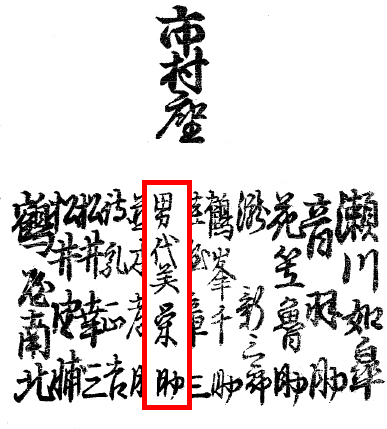 |
|
|
The name of Oyomi Eisuke in a 1823 Edo hy˘banki (the name within the red box) |
|
| Sawaarashi T˘r˘ Sawaarashi T˘r˘ |
|
|
Dates of birth and death unknown. Disciple of Chikamatsu Tokuz˘, his first pen name was Sawaarashi Ichiz˘ and he was recorded for the first time in the 9th lunar month of 1812, when he worked at the Kado no Shibai on the drama "Katakiuchi Chikai no Shigarami" [25]. He took the name of Sawaarashi T˘r˘ in the 9th lunar month of 1819, when he worked at the Naka no Shibai on the drama "T˘t˘migata Koi no Shiranami". He worked in the 11th lunar month of 1822 at the Naka no Shibai on the drama "Sugawara Denju Tenarai Kagami" [26]. He also worked in the 11th lunar month of 1824 at the Minamigawa no Shibai on the drama "Kokusen'ya Gassen" [27]. He worked in tabi shibai during the Tenp˘ era. He was recorded for the last time when he worked in the 8th lunar month of 1841 in the Kado no Shibai on the drama "ďodori Kiriko no Akebono". No record afterwards. |
|
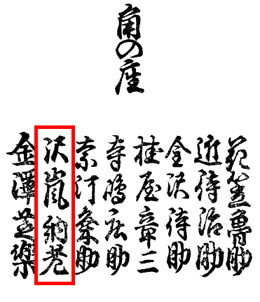 |
|
|
The name of Sawaarashi T˘r˘ in a 1826 Kamigata hy˘banki (the name within the red box) |
|
| Sawai Chűz˘ Sawai Chűz˘ |
|
|
Dates of birth and death unknown. He was recorded for the first time in the 11th lunar month of 1748, when he worked at the Nakamuraza in the kaomise drama "Onna Moji Heike Monogatari". He was recorded for the last time when he worked in the 11th lunar month of 1773 at the Moritaza on the kaomise drama "Onna Aruji Hatsuyuki no Sekai" [5]. No record afterwards. As a sakusha, he worked for 25 years on more than 50 original dramas. |
|
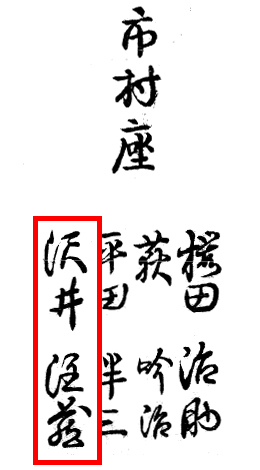 |
|
|
The name of Sawai Chűz˘ in a 1769 Edo hy˘banki (the name within the red box) |
|
| Sawai Sh˘z˘ Sawai Sh˘z˘ |
|
|
Dates of birth and death unknown. He was recorded for the first time in the 1st lunar month of 1750, when he worked at the Nakamuraza on the new year sogamono drama "ďkazari Saiwai Soga". He was recorded for the last time when he worked in the 2nd lunar month of 1763 at the Ichimuraza on the new year sogamono drama "Fűjibumi Sakae Soga" [24]. No record afterwards. |
|
| Sawano Gensuke Sawano Gensuke |
|
|
Dates of birth and death unknown. He was recorded for the first time in the 11th lunar month of 1745, when he worked in Ky˘to on the kaomise drama "Kachidoki Manzairaku" [23] which was produced by Nakamura Kiyosabur˘ I for the nadai Miyako Handayű. He was recorded for the last time when he worked in the 7th lunar month of 1746 in the same theater on the drama "Musume Nuregami Otoko Musubi Mitsu-ga-Hama". No record afterwards. |
|
| Shibazaki Genz˘ Shibazaki Genz˘ |
|
|
Dates of birth and death unknown. He was recorded for the first time in the 12th lunar month of 1761, when he worked at the Kado no Shibai on Namiki Sh˘z˘ I's ni-no-kawari drama "Taihei Iroha Gy˘retsu". He was recorded for the last time when he worked in the 11th lunar month of 1765 in ďsaka at the Wakadayű no Shibai [22] on the kaomise drama "Hanayagura Kikigaki Taiheiki". No record afterwards. |
|
| Shimada K˘z˘ Shimada K˘z˘ |
|
|
Dates of birth and death unknown. He was recorded for the first time in the 10th lunar month of 1784, when he worked at the Naka no Shibai on the drama "Hana-ha Sakura Ak˘ no Shiogama". He was recorded for the last time in the 1789 ďsaka hy˘banki. No record afterwards. |
|
| Shimizu Katsuji Shimizu Katsuji |
|
|
Dates of birth and death unknown. Was he a disciple of Shimizu Sh˘shichi I? No proof to support this assumption. He was recorded for the first time in the 11th lunar month of 1797, in Edo at the Nakamuraza, where he worked for Sakurada Jisuke I and Muraoka K˘ji I on the kaomise drama "Kaikei Koky˘ no Nishikigi", which celebrated the shűmei of Arashi Shichigor˘ III and Hanai Saizabur˘ IV. He was recorded for the last time in the 8th lunar month of 1798 in the same theater where he worked on the drama "Irifune Shinoda no Dekiaki". No record afterwards. |
|
 |
|
|
The name of Shimizu Katsuji in a 1798 Edo hy˘banki (the name within the red box) |
|
| Sono Bunpei Sono Bunpei |
|
|
Dates of birth and death unknown. He was recorded for the first time in the 5th lunar month of 1780, when he worked for Sakurada Jisuke I in Edo at the Ichimuraza. He worked for Sakurada Jisuke I and Kasanui Sensuke I at the Ichimuraza in the 11th lunar month of 1780 on the kaomise drama "Mure Takamatsu Yuki no Shirahata". He was recorded for the last time in the 1st lunar month of 1784, in Edo at the Ichimuraza, where he worked on the new year drama "Keisei Satsuki no Fuji". No record afterwards. |
|
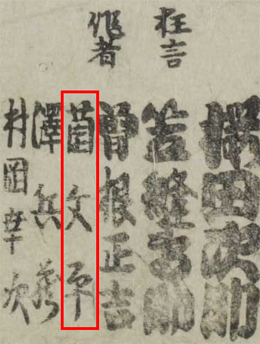 |
|
|
The name of Sono Bunpei in a 1780 Ichimuraza yakuwari banzuke (the name within the red box) |
|
| Sono T˘hachi Sono T˘hachi |
|
|
Dates of birth and death unknown. He was recorded for the first time in the 11th lunar month of 1786, in Edo at the Moritaza, where he worked for Segawa Jok˘ I on the kaomise drama "Onna Musha Kiku no Sen'yoki", which celebrated the shűmei of Sawamura Kameemon and Nakamura Kichisabur˘ III. He was recorded for the last time in the 1st lunar month of 1795, in Edo at the Miyakoza, where he worked for Namiki Gohei I and Matsui Yűsuke I on the new year sogamono drama "Edo Sunago Kichirei Soga". No record afterwards. |
|
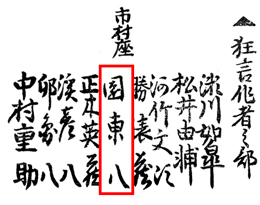 |
|
|
The name of Sono T˘hachi in a 1793 Edo hy˘banki (the name within the red box) |
|
| Tamaya Tamasuke Tamaya Tamasuke |
|
|
Born in Kii in 1818. He was recorded for the first time in the 11th lunar month of 1855, in Ky˘to at the Kitagawa no Shibai, where he worked with Kin Shir˘ on the kaomise drama "Yaemusubi Jiraiya Monogatari". He was recorded for the last time in the 11th lunar month of 1856, in Ky˘to at the Minamigawa no Shibai, where he worked on the kaomise drama "Iroha Uta Hana no Shűitsu". No stage record afterwards. He died in 1864. |
|
 |
|
|
The name of Tamaya Tamasuke in a 1855 Ky˘to hy˘banki (the name within the red box) |
|
| Umezawa S˘roku Umezawa S˘roku |
|
|
Dates of birth and death unknown. He was recorded for the first time in the 11th lunar month of 1848, in Edo at the Kawarasakiza, where he worked [41] on the on the drama "Azuma Dairi Hana mo Yoshikado". Premiere in the 2nd lunar month of 1853 at the Kawarasakiza of Kawatake Shinshichi II's drama "Shiranui Monogatari", which was based on Ryűkatei Tanekazu's long novel of the same title [more details]. Premiere in the 3rd lunar month of 1854 at the Kawarasakiza of Kawatake Shinshichi II's drama "Miyakodori Nagare no Shiranami" [casting]. Premiere in the 9th lunar month of 1856 at the Ichimuraza of Kawatake Shinshichi II's 9-act drama "Tsuta Momiji Utsunoya T˘ge". Premiere in the 3rd lunar month of 1858 at the Ichimuraza of Kawatake Shinshichi II's drama "Edo Zakura Kiyomizu Seigen"; the nibanme of this drama is now entitled "Kurotegumi Kuruwa no Tatehiki" in the Kabuki repertoire (commonly called "Kurotegumi Sukeroku") [more details]. Premiere in the 2nd lunar month of 1859 at the Ichimuraza of Kawatake Shinshichi II's drama "Kosode Soga Azami no Ironui" (commonly called "Izayoi Seishin") [casting]. He was recorded for the last time in the 1st lunar month of 1865, in Edo at the Ichimuraza, where he worked for Kawatake Shinshichi II on the sogamono drama "Tsuru no Chitose Soga no Kadomatsu". No record afterwards. |
|
 |
|
|
The name of Umezawa S˘roku in a 1865 Ichimuraza yakuwari banzuke (the name within the red box) |
|
| Yamada Heiz˘ Yamada Heiz˘ [7] |
|
|
Dates of birth and death unknown. He was recorded for the first time in the 2nd lunar month of 1771, when he worked at the Ichimuraza on the drama "Wada Sakamori Osame no Mitsugumi". He was recorded for the last time when he worked in the 11th lunar month of 1780 at the Nakamuraza on the kaomise drama "Kite Kaeru Nishiki no Wakayaka" [6]. No record afterwards. As a sakusha, he worked less than 10 years on more than 10 original dramas. |
|
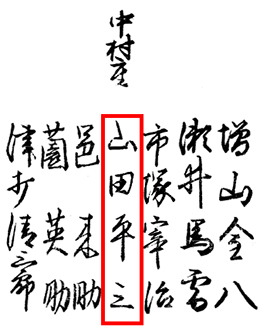 |
|
|
The name of Yamada Heiz˘ in a 1780 Edo hy˘banki (the name within the red box) |
|
|
|
|
|
[1] The others sakusha were Tsuruya Nanboku IV, Segawa Jok˘ II, Mimasuya Nis˘ji, Matsui Yűsuke II, Katsui Genpachi, Katsu Hy˘suke, Terashima Gosuke, Matsuchi Sh˘kichi and Hanagasa Rosuke. [2] The others sakusha were Fukumori Kyűsuke I, Katsu Hy˘z˘ I, Sakurada Jisuke II, Shimizu Sh˘shichi I, Tsuchii Hy˘shichi I, Katsuura Shűz˘, Narita Yasuke, Kameyama Tamesuke and Tana S˘hachi I. [3] The others sakusha were Masuyama Kinpachi I, Dontsű Yosabŕ I, Kawatake Shinshichi I, Okuno Sasuke and Nishikawa Sensuke. [4] The main sakusha were Sakurada Jisuke I, Kawatake Shinshichi I and Okuno Sasuke. [5] The others sakusha were Masuyama Kinpachi I, Horikoshi Saiy˘, Kasanui Sensuke I, Yamada Heiz˘ and Hasegawa Zenkichi. [6] The sakusha were Kawatake Shinshichi I, Kawatake Bunji, Kawatake Matsuz˘, Tsuuchi Seizabur˘ and Nakamura Raisuke. [7] Another possible reading was Yamada Heiza. [8] Another possible reading was Naka Hanza. [9] The main sakusha were Kanai Sansh˘, Masuyama Kinpachi I, Kawai Kinji and Umeda Toshisuke. [10] The roles of Kud˘ Saemon Suketsune, Soga Gor˘ Tokimune and Soga Jűr˘ Sukenari were played by Sakata Hangor˘ II, Sanogawa Ichimatsu II and Ichimura Uzaemon IX. [11] The others main sakusha were Kawatake Shinshichi I and Okuno Sasuke. [12] The tatesakusha was Nagawa Shimesuke I. [13] The main sakusha were Nagawa Shimesuke I and Namiki Jusuke. [14] The others sakusha were Sawamura Ayasuke, Nakayama Otohachi, Sawanaka Y˘suke, Nakanogawa T˘shichi and Nakanogawa Genpachi. [15] The main sakusha were Suketakaya Takasuke I, Namiki Ry˘suke and Tsuuchi Sabur˘ji. [16] The main sakusha were Sakurada Jisuke I and Ogi Kinji. [17] The others sakusha were Sawamura Ayasuke, Nakayama Otohachi, Sawanaka Y˘suke, Nakamatsu Bunz˘ and Nakanogawa Genpachi. [18] The others sakusha were Sawamura Ayasuke, Sawanaka Y˘suke, Nakamatsu Bunz˘, Nakanogawa T˘shichi and Nakanogawa Genpachi. [19] He worked with Sawamura Bunji. [20] Tsuuchi Jihŕ II went to Kamigata his adopted son Tsuuchi Monzabur˘ I and with the actor Band˘ Hikosabur˘ I. [21] He worked with Tsuuchi Hanjűr˘ and Yasuda Abun. [22] The Wakadayű no Shibai was a hama shibai venue in ďsaka. [23] The others sakusha were Narumi Yatar˘ and Sawano S˘heiji. [24] The others sakusha were Tsuuchi Jihŕ III (tatesakusha), Sawai Chűz˘, Nakamura Seikur˘ II and Tsuuchi Denjűr˘ II. [25] The tatesakusha was Nagawa Shimesuke I. [26] The others sakusha were Nagawa Harusuke I, Nagawa Kansuke, Nagawa Rikisuke and Nagawa Daisuke. [27] The others sakusha were Nagawa Harusuke I and Kanazawa Haruz˘. [28] The others sakusha were Sawai Chűz˘, Azuma S˘suke and Horikoshi Heijűr˘. [29] The roles of Kud˘ Saemon Suketsune, Soga Gor˘ Tokimune and Soga Jűr˘ Sukenari were played by Sawamura S˘jűr˘ II, Band˘ Hikosabur˘ II and Ichimura Kamez˘ I. [30] The others sakusha were Sawai Chűz˘ and Tsuda Mataichi. [31] The others sakusha were Sawai Chűz˘ and Tsuuchi Seisuke. [32] The others sakusha were Hata Bunsuke, Kawatake Shinshichi I, Okuno Sasuke and Shima Banroku. [33] The others sakusha were Dontsű Yosabŕ I, Kawatake Shinshichi I, Okuno Sasuke and Hirata Bunji. [34] Was Sakurada Bunpei the first pen name of Sono Bunpei ? The name of Sakurada Bunpei was recorded only once, in the 1780 Edo hy˘banki. He worked at the Ichimuraza in the 11th lunar month of 1779 on the kaomise drama "Azuma no Mori Sakae Kusunoki", which celebrated the shűmei of Azuma T˘z˘ III and Segawa Otome. He also worked in the same theater in the 1st lunar month of 1780 on the new year sogamono drama "Ume Goyomi Akebono Soga". In the 11th lunar month of 1780, in the same theater with the same tatesakusha Sakurada Jisuke I, no more Sakurada Bunpei but Sono Bunpei in the list of sakusha. [35] The others sakusha were Tatsuoka Mansaku, Nakamura Akei, Hasemura Shinshichi and Tsuuchi Teisuke. [36] The others sakusha were Nagawa Kamesuke I, Namiki Jűsuke I, Namiki Takichi and ďtani Jinkichi. [37] This is our assumption. These two actors were recorded as performing together. For example in the 11th lunar month of 1745 in ďsaka at the Naka no Shibai, they performed together in the kaomise drama "Onna Musha Ukisu Gassen". [38] He was recorded as Chikamori Tokuji in Nojima Jusabur˘'s book "Kabuki Jinmei Jiten". [39] The others sakusha were Tanabe Yashichi, Chikamatsu Y˘suke and Chikamatsu Tokubei. [40] Another possible reading of this title could be "Muro no Ume Hangan Biiki". This drama was premiered in the 11th lunar month of 1817 at the Miyakoza. The others main sakusha were Matsui K˘z˘ II, Shinoda Kinji I and Tajima Konosuke I. [41] The others sakusha were Mimasuya Nis˘ji, Kawatake Shinshichi II, Shinoda Sasuke, Matsumoto K˘ji II & Katsumi Ch˘z˘. [42] The others sakusha were Okuno Sasuke, Nakamura Seikur˘ II & Okuno Eiji. [43] The others sakusha were Namiki Sh˘z˘ II, Tatsuoka Mansaku & Shimada Tsuruz˘. |
|
|
|
| Contact | Main | Top | Updates | Actors | Plays | Playwrights | Programs | Links | FAQ | Glossary | Chronology | Illustrations | Prints | Characters | Derivatives | Theaters | Coming soon | News |